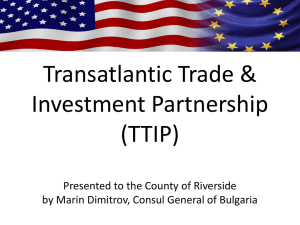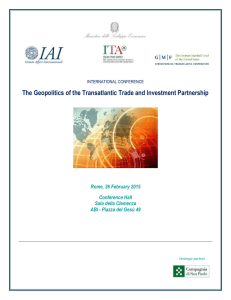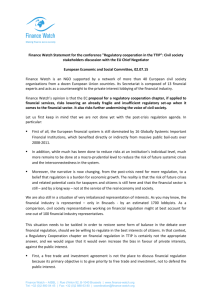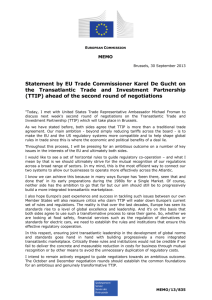Electrical Machinery and TTIP
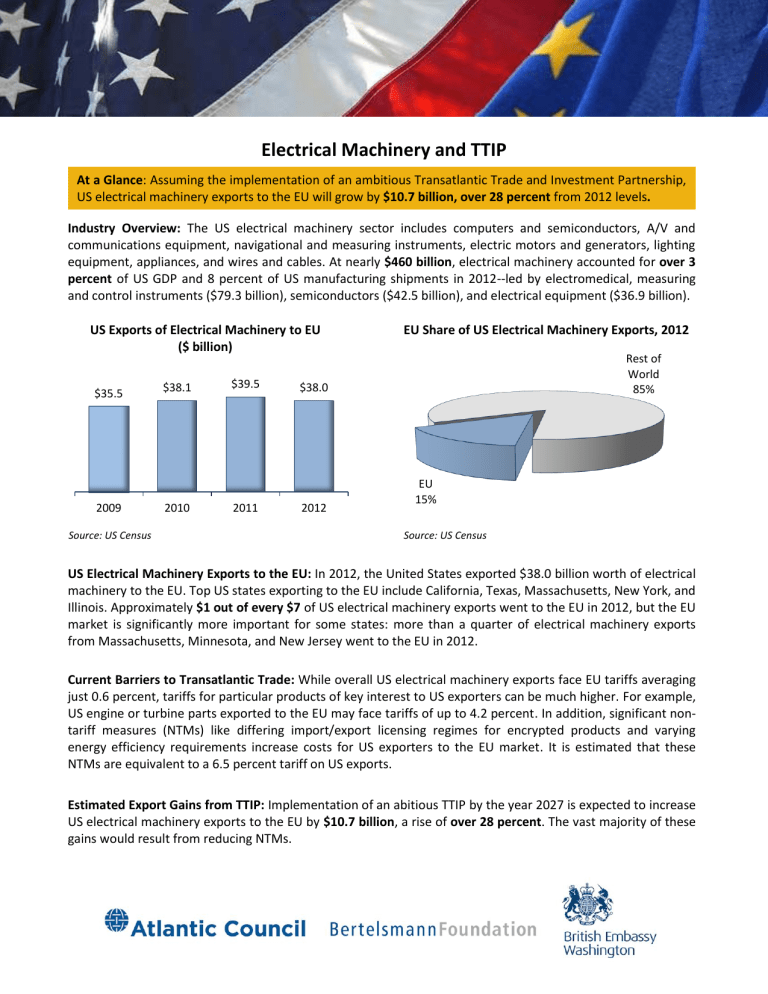
Electrical Machinery and TTIP
At a Glance : Assuming the implementation of an ambitious Transatlantic Trade and Investment Partnership,
US electrical machinery exports to the EU will grow by $10.7 billion, over 28 percent from 2012 levels .
Industry Overview: The US electrical machinery sector includes computers and semiconductors, A/V and communications equipment, navigational and measuring instruments, electric motors and generators, lighting equipment, appliances, and wires and cables. At nearly $460 billion , electrical machinery accounted for over 3 percent of US GDP and 8 percent of US manufacturing shipments in 2012--led by electromedical, measuring and control instruments ($79.3 billion), semiconductors ($42.5 billion), and electrical equipment ($36.9 billion).
US Exports of Electrical Machinery to EU
($ billion)
$35.5
$38.1
$39.5
$38.0
2009
Source: US Census
2010 2011 2012
EU Share of US Electrical Machinery Exports, 2012
EU
15%
Source: US Census
Rest of
World
85%
US Electrical Machinery Exports to the EU: In 2012, the United States exported $38.0 billion worth of electrical machinery to the EU. Top US states exporting to the EU include California, Texas, Massachusetts, New York, and
Illinois. Approximately $1 out of every $7 of US electrical machinery exports went to the EU in 2012, but the EU market is significantly more important for some states: more than a quarter of electrical machinery exports from Massachusetts, Minnesota, and New Jersey went to the EU in 2012.
Current Barriers to Transatlantic Trade: While overall US electrical machinery exports face EU tariffs averaging just 0.6 percent, tariffs for particular products of key interest to US exporters can be much higher. For example,
US engine or turbine parts exported to the EU may face tariffs of up to 4.2 percent. In addition, significant nontariff measures (NTMs) like differing import/export licensing regimes for encrypted products and varying energy efficiency requirements increase costs for US exporters to the EU market. It is estimated that these
NTMs are equivalent to a 6.5 percent tariff on US exports.
Estimated Export Gains from TTIP: Implementation of an abitious TTIP by the year 2027 is expected to increase
US electrical machinery exports to the EU by gains would result from reducing NTMs.
$10.7 billion , a rise of over 28 percent . The vast majority of these
Methodology
This study depicts the estimated economic impact of the implementation of an ambitious Transatlantic Trade and
Investment Partnership (TTIP) on US exports and employment for a series of fourteen key economic sectors. The estimated changes in exports to the EU are based on the Centre for Economic Policy Research (CEPR) report
Reducing Transatlantic Barriers to Trade and Investment: An Economic Assessment , The Trade Partnership’s
CDxports database, and the approach used by Ecorys to quantify non-tariff measures. According to the CEPR study, an agreement would increase US GDP by up to €95 billion, or $125 billion at current exchange rates, under its ambitious scenario.
The CEPR study defines an ambitious agreement as: 1) a 100 percent reduction in tariffs, 2) a 25 percent reduction in the costs resulting from non-tariff measures such as regulatory barriers affecting goods and services, and 3) a 50 percent reduction in procurement non-tariff barriers. CEPR’s study estimates reflect the full implementation of an ambitious TTIP agreement by the year 2027. The results are based on an estimated change derived from TTIP compared to a 2027 baseline year without the TTIP in place. Our figures for exports and job creation take into account the countervailing forces of increased imports to the US from the EU.
Employment impacts were derived under the same TTIP liberalization scenarios as in the CEPR report. However, while the core CEPR assessment is a long-run assessment based on an assumption of full employment, Moody’s forecasts include continued soft labor markets in 2027, with unemployment above long run levels. We therefore conducted an alternative measure of the potential impact of TTIP on employment reflecting an economy that is not at full employment in 2027. This involved assumptions of both increased labor demand and increased wages.
Resulting national impacts by industry were distributed to the state level based on Moody’s baseline state and sector level labor force projections.
It is important to note that the largest positive effects of the TTIP arise from the agreement’s indirect impacts on
US spending and investment. For example, due to the lower costs of imports, companies and consumers have additional resources available to spend on other goods and services, and that spending is itself job supporting.
According to European Commission estimates, TTIP increases disposable income by approximately $865 annually for an average American family of four.
1
Dataset used in this study
The study was conducted using export data for goods and services from The Trade Partnership’s CDxports database. CDxports refines US government export data to estimate merchandise exports to more than 230 countries from individual US states and Congressional districts. It details exports for 104 sectors for 2002 through
2012. This analysis uses figures for goods exports to the EU
2
and services exports to the EU
3
, based on the most recent data available at the time of publishing.
Terminology
The terminology used to describe current US exports to the EU in this study is based on the Census Bureau’s North
American Industry Classification System (NAICS). The CEPR study, by contrast, uses a more broadly defined classification of industry categories based on those in the CEPR study. The two classification systems are interoperable. For instance, logging, fishing, support activities for crop production, animal production, and forestry fall within the right-hand classification “Ag., Forestry, Fisheries.” Services agglomerations include the following:
Business services (legal, accounting, architecture, engineering, management consulting, etc.), personal services
(arts, entertainment, lodging, food services, maintenance and repair, beauty services, etc.), and other services
(utilities, wholesale and retail sales, domestic transportation, education, health care, etc.).
1
2
http://ec.europa.eu/trade/policy/in-focus/ttip/questions-and-answers/
3
Based on 2012 data
Based on 2011 data, the most recent available at the time of publishing
